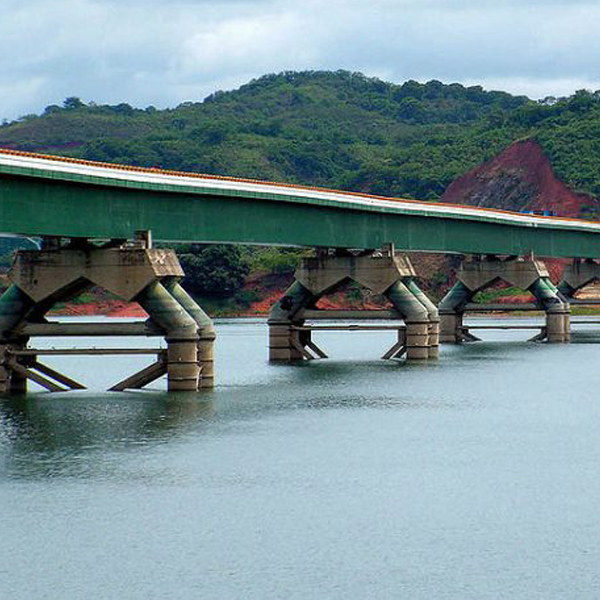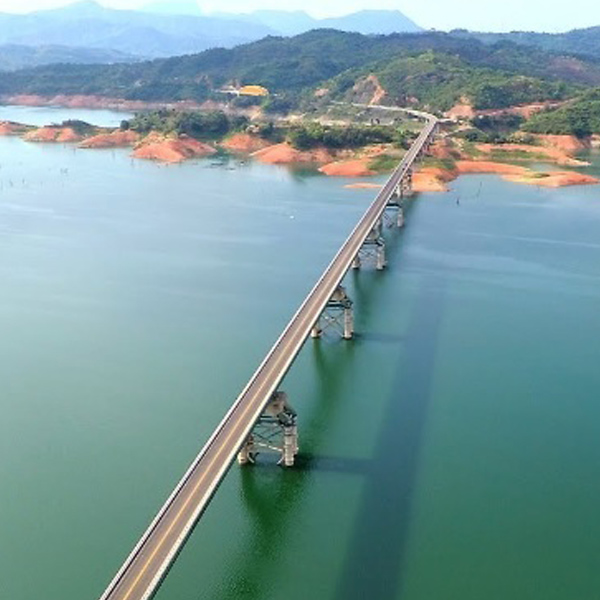Chiapas Bridge – Mexico
About The Bridge
The Chiapas Bridge is a steel bridge over a kilometer in length which spans the Nezahualcoyotl or Malpaso Dam in northern Chiapas, Mexico. It is 1,208 meters long and 8 meters wide connecting Veracruz and Chiapas. . Construction of the bridge began in 2002 and finished fourteen months later, voted the best infrastructure project in Mexico in 2004. Its exact location is Km 961 of the Coapas-Ocozocoautla highway and cuts the travel time from Mexico City to Chiapas by roughly 3.5 hours. It makes the rural area in northern Chiapas more accessible and open to ecotourism.
The bridge is ten meters wide, with eight supports, seven pillars or “jackets” and one strip of concrete fastened onto solid land. The upper part of the bridge is made of orthotropic materials with 102 metal voussoirs which weigh 8,900 tons with an average weight of eight tons per meter. The total amount of steel used s over 19,000 tons, the equivalent of four ocean platforms.
Objective
The objective was to monitor the integrity and behavior of the bridge structure, and the kinds of effects cause by high traffic and heavy loads that may cause damage and fatigue. There are strain and temperature sensors in 16 different locations and the system is run on solar power.
Project
In late 2008, the fiber optic structural health monitoring (SHM) system was installed on the Chiapas Bridge in Mexico. This installation represents the first SHM instrumented bridge in Mexico using optical fiber sensors and SHM techniques. The project was conceived and managed by the Structures Department within the Institute of Engineering at the National Autonomous University (UNAM) in Mexico, under contract from the Mexican Transportation Undersecretary. The system was designed by MCH Engineering LLC.
During construction of the superstructure, a basic monitoring system was initially implemented to monitor and assess the structural behavior of the bridge. However, advances in SHM techniques and the importance of the Chiapas Bridge in the region, prompted the need for a new and advanced instrumentation system. The new solution is based on a multi-point, multi-sensor monitoring system based on optical fiber Bragg grating sensors and opto-electronic interrogators. The system is self contained, works as a stand-alone equipment and allows for the in-situ, real-time monitoring of the bridge as well as its long-term condition. A total of 82 fiber optic strain and temperature sensors were installed in key bridge locations. Local electric power is supplied by a solar panel system.
The monitoring system instrumentation is composed of a single optical interrogator (Micron Optics model sm130-500) with 4 optical channels, scanning at 1khz; a 4×16 channel sensor multiplexer (model sm041-416) and a sp130 controller and data acquisition. The system can be configured to record data at any specific interval and to any threshold level.
The Chiapas bridge was opened to traffic in 2003 and is the most important structure of an entire highway going through the state of Chiapas, in Southwest Mexico, and part of the Transamerican highway system. The superstructure is a continuous grade 50 steel orthotropic box of constant height comprising 8 spans, with a total length of 1208m. Piers heights range from 27 to 89 m measured from the bottom of the dam. Steel jackets of the offshore type, were used as the main elements of the piers.
Equipment/ Instrumentation – Micron Optics
- (1) sm130-500
- (1) sp130-500
- (1) sm041-416
Sensors
- (16) os3100 Spot-Weld Strain Gage
- (16) os4100 Temperature Comp. Sensors






